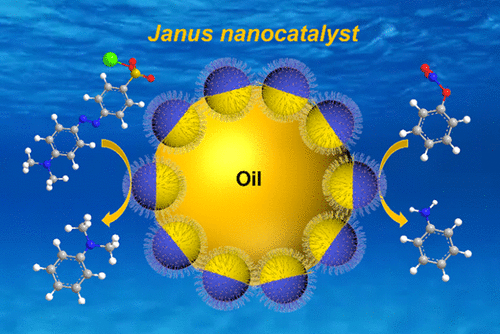当前位置:
X-MOL 学术
›
ACS Appl. Nano Mater.
›
论文详情
Our official English website, www.x-mol.net, welcomes your
feedback! (Note: you will need to create a separate account there.)
Construction of Polymer-Decorated Fe3O4@Catechol-formaldehyde Resin Amphiphilic Janus Nanospheres for Catalytic Applications
ACS Applied Nano Materials ( IF 5.3 ) Pub Date : 2022-04-14 , DOI: 10.1021/acsanm.2c00595
Donghui Cui 1 , Bingfeng Shi 1 , Zhinan Xia 1 , Wenjing Zhu 1 , Changli Lü 1
ACS Applied Nano Materials ( IF 5.3 ) Pub Date : 2022-04-14 , DOI: 10.1021/acsanm.2c00595
Donghui Cui 1 , Bingfeng Shi 1 , Zhinan Xia 1 , Wenjing Zhu 1 , Changli Lü 1
Affiliation

|
Janus particles are widely used as multifunctional materials for catalytic reactions due to their controllable asymmetry and stability efficiency of the interface structure. Herein, we propose a simple approach to design an amphiphilic “hairy” Janus nanocatalyst, which is composed of Fe3O4@catechol-formaldehyde resin (CFR) core–shell microspheres with different hydrophilic–hydrophobic polymer chains grafted on opposite sides of the microsphere and the catalytically active metal particles directly supported on the hydrophilic polymer chains. Amphiphilic Janus nanospheres (200–300 nm) with hydrophilic poly (N-isopropylacrylamide) (PNIPAM) and hydrophobic polystyrene (PSt) chains are synthesized by Pickering emulsion and mussel-inspired methods, followed by in situ reduction of Pd nanoparticles (Pd NPs) loaded onto the hydrophilic polymer chain side to form a Janus-structured Pd@PNIPAM-S-Fe3O4@CFR-S-PSt nanocatalyst. The amphiphilic Janus nanospheres have a good effect on the stability of the emulsion. Due to its special structural composition, the constructed Janus nanocatalyst exhibits excellent catalytic reduction performance for dyes and nitroaromatic compounds in both water and emulsion phases. Because of the existence of Fe3O4, the catalyst is easy to be separated and recovered, which augments the catalytic reaction cycle. In addition, the presence of temperature-sensitive PNIPAM polymer chains also enables the Janus nanocatalyst to display controllable temperature-responsive behaviors in stabilizing emulsions and emulsion catalysis. The as-prepared Janus nanomaterials with a variety of functions and properties possess potential for application in catalysis and biological and environmental areas.
中文翻译:

用于催化应用的聚合物修饰的 Fe3O4@儿茶酚甲醛树脂两亲 Janus 纳米球的构建
Janus颗粒由于其可控的不对称性和界面结构的稳定性效率而被广泛用作催化反应的多功能材料。在此,我们提出了一种简单的方法来设计一种由 Fe 3 O 4组成的两亲“毛状”Janus 纳米催化剂。@儿茶酚-甲醛树脂(CFR)核壳微球,在微球的两侧接枝有不同的亲水-疏水聚合物链,催化活性金属颗粒直接负载在亲水性聚合物链上。通过皮克林乳液和贻贝启发方法合成了具有亲水性聚(N-异丙基丙烯酰胺)(PNIPAM)和疏水性聚苯乙烯(PSt)链的两亲性 Janus 纳米球(200-300 nm),然后原位还原 Pd 纳米颗粒(Pd NPs)负载到亲水性聚合物链侧形成 Janus 结构的 Pd@PNIPAM-S-Fe 3 O 4@CFR-S-PSt 纳米催化剂。两亲性Janus纳米球对乳液的稳定性有很好的影响。由于其特殊的结构组成,所构建的 Janus 纳米催化剂在水相和乳液相中对染料和硝基芳族化合物均表现出优异的催化还原性能。由于 Fe 3 O 4的存在,催化剂易于分离和回收,增加了催化反应循环。此外,温度敏感的 PNIPAM 聚合物链的存在也使 Janus 纳米催化剂在稳定乳液和乳液催化中表现出可控的温度响应行为。所制备的具有多种功能和性质的Janus纳米材料具有在催化、生物和环境领域的应用潜力。
更新日期:2022-04-14
中文翻译:

用于催化应用的聚合物修饰的 Fe3O4@儿茶酚甲醛树脂两亲 Janus 纳米球的构建
Janus颗粒由于其可控的不对称性和界面结构的稳定性效率而被广泛用作催化反应的多功能材料。在此,我们提出了一种简单的方法来设计一种由 Fe 3 O 4组成的两亲“毛状”Janus 纳米催化剂。@儿茶酚-甲醛树脂(CFR)核壳微球,在微球的两侧接枝有不同的亲水-疏水聚合物链,催化活性金属颗粒直接负载在亲水性聚合物链上。通过皮克林乳液和贻贝启发方法合成了具有亲水性聚(N-异丙基丙烯酰胺)(PNIPAM)和疏水性聚苯乙烯(PSt)链的两亲性 Janus 纳米球(200-300 nm),然后原位还原 Pd 纳米颗粒(Pd NPs)负载到亲水性聚合物链侧形成 Janus 结构的 Pd@PNIPAM-S-Fe 3 O 4@CFR-S-PSt 纳米催化剂。两亲性Janus纳米球对乳液的稳定性有很好的影响。由于其特殊的结构组成,所构建的 Janus 纳米催化剂在水相和乳液相中对染料和硝基芳族化合物均表现出优异的催化还原性能。由于 Fe 3 O 4的存在,催化剂易于分离和回收,增加了催化反应循环。此外,温度敏感的 PNIPAM 聚合物链的存在也使 Janus 纳米催化剂在稳定乳液和乳液催化中表现出可控的温度响应行为。所制备的具有多种功能和性质的Janus纳米材料具有在催化、生物和环境领域的应用潜力。

































 京公网安备 11010802027423号
京公网安备 11010802027423号